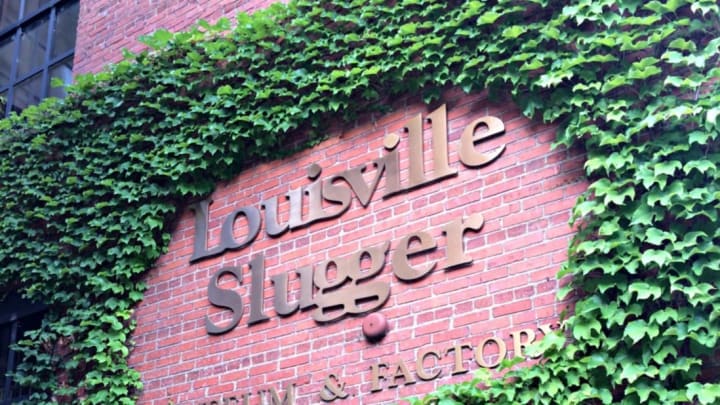You may not know the names “Hillerich and Bradsby,” but you almost certainly know their most famous product—the Louisville Slugger.
Back in the mid-1850s, J.F. Hillerich moved his family from Germany to Louisville, Kentucky. They opened up a woodworking shop and made “everything from balusters to bedposts.” When Hillerich’s oldest son Bud wasn’t playing amateur baseball in the 1880s, he used his dad’s shop to turn bats for himself and his teammates.
Legend has it that the first professional Hillerich bat was made when Bud was watching his hometown pro team play in 1884. When star Louisville Eclipse player Pete Browning broke a bat, Bud offered to bring him down to the shop and make one to his exact specifications. Browning accepted the offer, and apparently got three hits with his new bat the very next game.
Though the elder Hillerich was reluctant to get into the bat-making business, the “Falls City Slugger” model was henceforth in such demand that he couldn’t really say no. They eventually changed the name of the product to Louisville Slugger (Browning’s nickname) and got their first endorsement deal in 1905: Honus “The Flying Dutchman” Wagner. It was the first time a professional athlete had ever endorsed a product. His signature was also the first to ever be used on a bat.
Stacy Conradt
Frank Bradsby entered the picture in 1911, when the Hillerichs decided it was time to bring in a focused sales and marketing person. Following their first advertising campaign in 1919, the company began producing one million bats a year—and they’re still going strong, since 60 percent of the big leaguers still use Louisville Sluggers. Each player typically goes through about 120 bats a year. You can see some of those pro bats being made if you visit the Louisville Slugger Museum and Factory Tour in downtown Louisville.
By shelling out a mere $12, you can hold a bat used by a pro (including Mickey Mantle’s), tour the factory floor, check out baseball exhibits, and even get your very own mini bat at the end of the tour.
No photos are allowed in the actual factory to protect trade secrets, but it’s a charming tour of the real plant floor. Workers demonstrate the old, 20-minute method of making bats with a hand lathe and calipers as well as the current 30-second method that involves programming specific weight and length requirements into an automated machine. Each bat is sanded and appropriately branded—some are silkscreened while others are stamped with a branding iron—and then hand-dipped in lacquer. Due to the massive amounts of maple and white ash being processed in a relatively small area, it’s probably the best-smelling factory tour you’ll ever take.
And if you don’t want to part with $12, you can always get your picture by their Big Bat for free. Propped up by the building as if Paul Bunyan casually left it there, the big bat is an exact replica of the chunk of wood Babe Ruth used to swing. The Bambino swung a bat that was merely 34 inches to 36 inches, though—this baby is 120 feet tall and 68,000 pounds. That’s because it’s made of steel, not hickory, Babe’s wood of choice.
